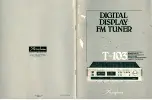
PAGE 21
Operation with LDG Electronics M1000 External Meter
The AT1000ProII has an external meter jack on the rear panel, which supports use of the
M1000 External Meter. The M1000 External Meter is an optional accessory for the AT1000ProII
that provides a large analog meter movement, and can be used to display Forward Power,
Reflected Power, and SWR.
Be sure to turn off your AT1000ProII before plugging in or unplugging the M1000 External
Meter.
The metered parameter displayed on the external meter need not be the same as the
parameter selected for viewing on the AT1000ProII’s built-in LED bargraphs, so it is possible to
watch two parameters at once! Consult the M1000 External Meter user manual for more details.
Tuning Hints
1.) The AT1000ProII is designed to allow fully automatic tuning, which causes a tuning
cycle to begin any time the SWR exceeds the user-selected threshold. However, tuning is not
allowed when the forward power exceeds a level that could damage the relays. If the
AT1000ProII is left in fully automatic mode with the amplifier active, it is possible to begin a
tuning cycle while transmitting high power in some circumstances, such as SSB transmission,
where the power level begins at a low level and then increases with voice peaks.
Once the power level exceeds the relay protection threshold, the tuning cycle will stop,
leaving the tuner in an un-tuned state. Because of this, LDG recommends switching the amplifer
off before tuning, and then once tuning is complete, the AT1000ProII should be switched to
semi-automatic mode (
FUNC -> Auto)
for as long as the amplifier is active, to prevent re-tuning
under high power.
2.) Some transceivers employ a fairly aggressive SWR roll-back circuit, which reduces
transmit power under high SWR conditions. It is possible, on a particularly mismatched antenna,
for the transmit power of the transceiver to be reduced so low that the frequency counter circuitry
of the AT1000ProII does not provide accurate information. For this reason, LDG suggests that
you tune with 20 to 50 watts of transmit power if tuning seems erratic when transmitting with
lower power levels. For many transceivers, this is a simple matter of switching the radio to AM
or RTTY mode and keying the mic.
THEORY OF OPERATION
Some basic ideas about impedance
The theory underlying antennas and transmission lines is fairly complex, and in fact employs
a mathematical notation called “complex numbers” that have “real” and “imaginary” parts. It is
beyond the scope of this manual to present a tutorial on this subject
4
, but a little background will
help in understanding what the AT-1000ProII is doing, and how it does it.
In simple DC circuits, the wire resists current flow, converting some of it into heat. The
relationship between voltage, current, and resistance is described by the elegant and well-known
4 For a very complete treatment of this subject, see any edition of the ARRL Handbook for Radio Communications (previously the Handbook For Radio Amateurs).
Summary of Contents for AT-1000PROII
Page 8: ...PAGE 8...








































